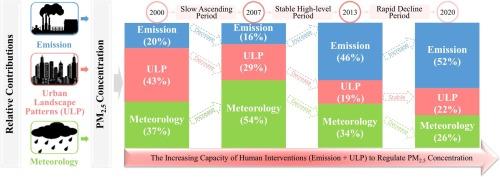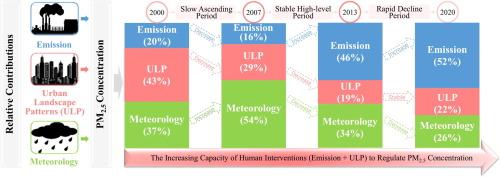人为干预对PM2.5浓度的调控能力大幅提升
IF 9.7
1区 环境科学与生态学
Q1 ENVIRONMENTAL SCIENCES
引用次数: 0
摘要
中国的快速城市化带来了严重的空气污染问题,随着城市化进程的继续,这一问题可能会持续相当长的一段时间。在城市地区,以PM2.5为代表的大气污染物的空间分布被证明主要受排放、城市景观格局(简称ULP)以及气象条件的影响。然而,随着城市发展的不同时期,这些因素的贡献可能会有很大的不同。基于多源数据,以中国304个地级市为研究区域,采用地理和时间加权回归(GTWR)模型,量化了排放、ULP和气象条件3个因子对PM2.5浓度在不同时期(2000-2007年缓慢上升期(SAP)、2007-2013年稳定高位期(SHP)和2013-2020年快速下降期(RDP)的相对贡献。SAP期间,排放的相对贡献保持在较低水平,ULP的相对贡献下降,气象因子对PM2.5浓度变化的贡献成为主导因素。在SHP和RDP期间,排放的相对贡献显著增加(增幅最大为28%),而气象因子的相对贡献显著减少(降幅最大为16%)。空间上,京津冀、汾渭平原、长三角、珠江三角洲等中国大气污染治理重点区域的气象贡献降幅(最大降幅为39%)明显大于其他区域,排放贡献增幅(最大增幅为66%)显著大于其他区域。总体而言,西南地区27个城市对气象条件的敏感性呈上升趋势,而大部分城市(共277个),特别是重点地区对排放的敏感性在整个时期呈上升趋势。这些结果证明,人为影响空气质量的能力逐渐增强,表明近年来中国大气污染防治政策取得了令人满意的效果。值得注意的是,大多数城市的PM2.5水平仍然对排放敏感。因此,未来仍需实施严格的减排措施,进一步改善空气质量。本文章由计算机程序翻译,如有差异,请以英文原文为准。


The capacity of human interventions to regulate PM2.5 concentration has substantially improved in China
The rapid urbanization in China has brought about serious air pollution problems, which are likely to persist for a considerable period as the urbanization process continues. In urban areas, the spatial distribution of air pollutants represented by PM2.5 has been proved mainly affected by emission, urban landscape pattern (short as ULP), as well as meteorological conditions. However, the contributions of these factors can seriously vary with different periods of urban development. Based on multi-source data, 304 prefecture-level cities in China were chosen as study areas, and we used the Geographically and Temporally Weighted Regression (GTWR) model to quantify the relative contributions of three factors—emission, ULP, and meteorological condition—to PM2.5 concentration variation in different periods, namely, the Slow Ascending Period (SAP, 2000–2007), the Stable High-level Period (SHP, 2007–2013), and the Rapid Decline Period (RDP, 2013–2020). During SAP, the relative contribution of emission remained low and the relative contribution of ULP decreased, while the contribution of meteorological factors to PM2.5 concentration variation becoming the dominant factor. During SHP and RDP, the relative contribution of emission notably increased (The largest increase is 28 %), while the relative contribution of meteorological factors significantly decreased (The largest decrease is 16 %). Spatially, the key regions for air pollution control in China, such as the Beijing-Tianjin-Hebei, the Fenwei Plain, the Yangtze River Delta, and the Pearl River Delta, experienced a significantly greater decrease (The largest decrease is 39 %) in the meteorological contribution and increase in the emission contribution (The largest increase is 66 %) compared to other regions. In general, we found that 27 cities in southwest China become increasingly sensitive to meteorological conditions, while the majority of cities (277 in total), particularly in key regions, have shown a growing sensitivity to emission during the whole period. These results prove that the ability of anthropogenic influence on air quality is gradually more effective, indicating the air pollution prevention and control policies in China in recent years have achieved satisfactory results. It is worthy to notice that the PM2.5 level in most cities is still sensitive to emissions. Therefore, strict emission reduction measures still needs to implemented in the future to further improve air quality.
求助全文
通过发布文献求助,成功后即可免费获取论文全文。
去求助
来源期刊

Environment International
环境科学-环境科学
CiteScore
21.90
自引率
3.40%
发文量
734
审稿时长
2.8 months
期刊介绍:
Environmental Health publishes manuscripts focusing on critical aspects of environmental and occupational medicine, including studies in toxicology and epidemiology, to illuminate the human health implications of exposure to environmental hazards. The journal adopts an open-access model and practices open peer review.
It caters to scientists and practitioners across all environmental science domains, directly or indirectly impacting human health and well-being. With a commitment to enhancing the prevention of environmentally-related health risks, Environmental Health serves as a public health journal for the community and scientists engaged in matters of public health significance concerning the environment.
 求助内容:
求助内容: 应助结果提醒方式:
应助结果提醒方式:


